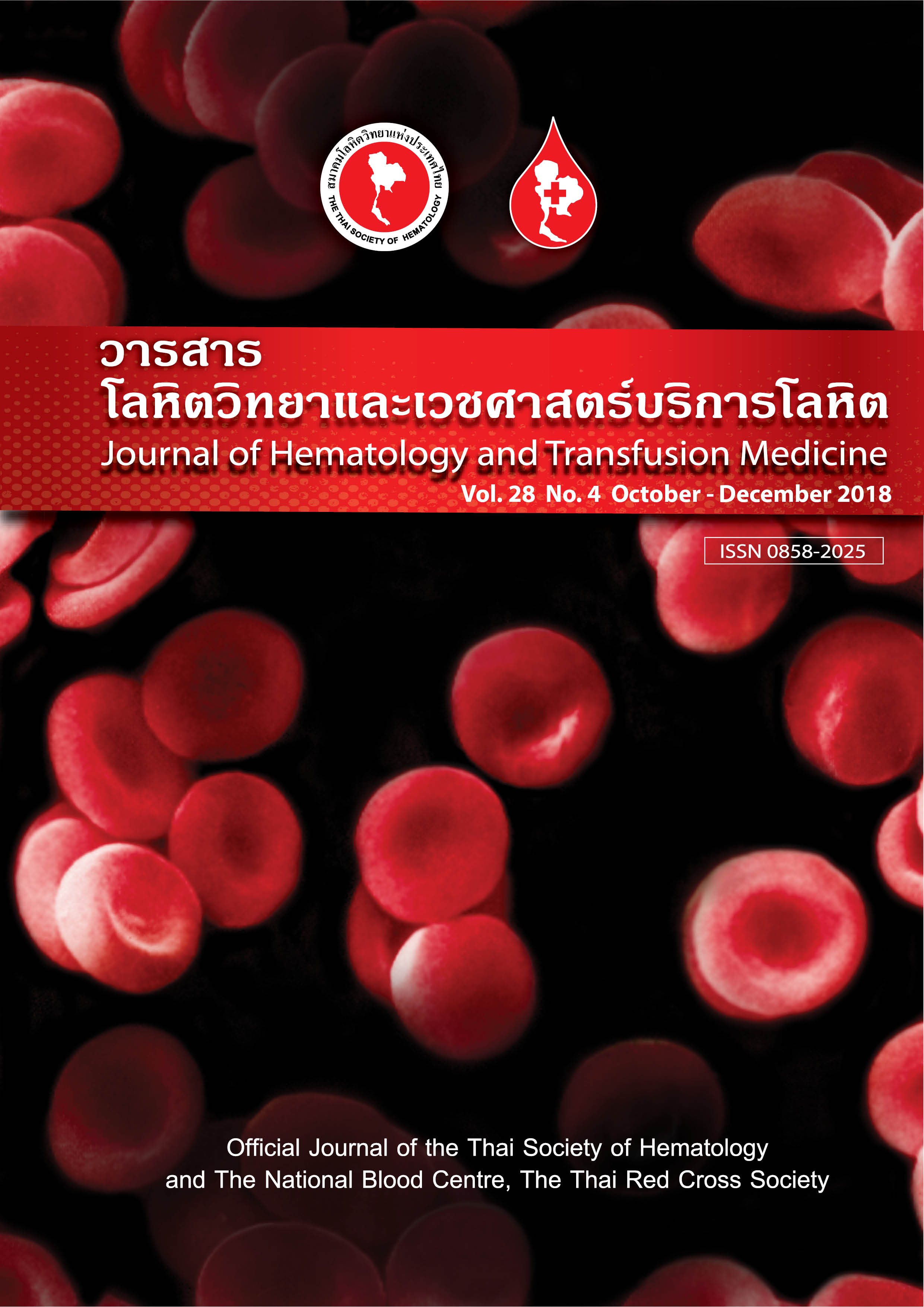The transiently high percentage of hemoglobin F during active hemolysis due to an autoimmune hemolytic anemia in a hemoglobin E trait
Keywords:
Autoimmune hemolytic anemia, Hemoglobin E trait, Transiently high hemoglobin FAbstract
Background: Actually the percentage of hemoglobin F in an adult hemoglobin E trait is around 0.9 ± 0.7% whereas Hb E is 29.4 ± 2.3%.
Objective: The study aimed to report an adult Hb E trait that had transiently high hemoglobin F during active hemolysis due an autoimmune hemolytic anemia (AIHA).
Case Presentation: A 19-year-old Thai woman presented with acute fever, chills, and jaundice for 3 days. The physical examination revealed a body temperature of 38.5 ํCelsis, PR 134/min, no goiter, marked pallor, mild jaundice and just palpable hepatosplenomegaly. The blood tests showed: Hb 3.6 g/dL, WBC 12 x109/L, platelet 331 x109/L, NRBC 11/100 WBC, MCV 133.0 fL, reticulocyte 5.0% and ferritin 91.2 ng/mL. Concerning Hb analysis by HPLC method: Hb E 28.7%, Hb F 8.7%, direct antiglobulin tests-positive, indirect bilirubin 1.7 mg/dL, ESR 119 mm/hour, ANA/ANF-positive, and coarse speckled nuclear titer > 1:1,280. Her diagnosis was acute hemolytic crisis due to an AIHA with underlying either Hb E heterozygosity or beta thalassemia / Hb E disease and treatment was corticosteroid. Six weeks later, her signs comprised Hb 13.0 g/dL, MCV 86.2 fL, Hb E 28.5%, Hb F 1.0%. The Hb E heterozygosity could be concluded. The percentage of Hb F in Hb E trait was found transiently high during the active hemolysis due to AIHA and became normal after the recovery of hemolysis.
Conclusion: During active hemolysis, the Hb analysis in Hb E trait should be delayed. Otherwise it may lead to the misdiagnosis of beta thalassemia / Hb E disease.
Downloads
References
2. Vichinsky E. Hemoglobin E syndromes. ASH Education Book.2007;2007:79-83.
3. Fucharoen S, Weatherall DJ. The hemoglobin E thalassemias. Cold Spring Harb Perspect. 2012;2:a011734.Doi:10.1101/ cshperspect.a011734
4. Fucharoen S, Fucharoen G, Sanchaisuriya K, Surapot S.Molecular characterization of thalassemia intermedia associated with HPFH-6/beta-thalassemia and HPFH-6/Hb E in Thai patients. Acta Haematol. 2002;108:157-61.
5. Bass GF, Tuscano ET, Tuscano JM. Diagnosis and classification of autoimmune hemolytic anemia. Autoimmun Rev. 2014;13:560-4.
6. Park SH. Diagnosis and treatment of autoimmune hemolytic anemia: classic approach and recent advances. Blood Res. 2016;51:69-71. doi:10.5045/br.2016.51.2.69
7. Prakobkaew N, Fucharoen S, Fucharoen G, Siriratmanawong N. Phenotypic expression of Hb F in common high Hb F determinants in Thailand: roles of alpha-thalassemia, 5’ delta-globin BCL11A binding region and 3’ beta-globin enhancer. Eur J Haematol. 2014;92:73-9.
8. Stamatoyannopoulos G, Veith R, Galanello R, Papayannopoulou T. Hb F production in stressed erythropoiesis: observations and kinetic models. Ann NY Acad Sci. 1985;445:188-97.
9. Steinberg MH, Thein SL. Fetal hemoglobin (hemoglobin F) in health and disease. In: UpToDate, Post TW (Ed), UpToDate, Waltham, MA. (Accessed on November 25, 2013.)
10. Wood WG, Stamatoyannopoulos G, Lim G, Nute PE. F-cells in the adult: normal values and levels in individuals with hereditary and acquired elevations of Hb F. Blood. 1975;46:671-82.
11. Wong P, Charoenporn P, Jermnim N, Sanguansermsri T. Betathalassemia/hemoglobin E with low hemoglobin F: report of 5 cases. Thai J Hematol Transf Med. 2006;16:323-6.
12. Kaferle J, Strzoda CE. Evaluation of macrocytosis. Am Fam Physicians. 2009;79:203-8.
13. Fucharoen S, Winichagoon P. Haemoglobinopathies in Southeast Asia. Indian J Med Res. 2011;134:498-506.
14. Srivorakun H, Singha K, Fucharoen G, Sanchaisuriya K, Fucharoen S. A large cohort of hemoglobin variants in Thailand: molecular epidemiological study and diagnostic consideration. PLoSOne. 2014;9(9): e108365.Doi:10.1371/journal.pone.0108365


